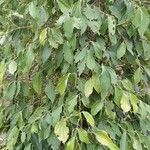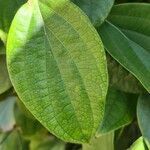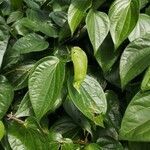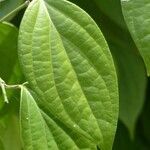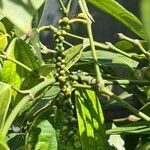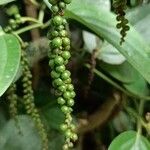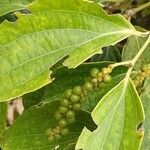Shrub sometimes with scrambling branches or liana. Stem glabrous. Petiole 1-2 cm long, glabrous, vaginate to apex; blade not scabrous, not glandular-dotted, elliptic, ovate to broadly ovate, 8-19 x 5-10 cm, apex acute to short-acuminate, base equal or almost equally attached to petiole, subacute to obtusish, glabrous; palmately-pinnately veined, secondary veins 2-3 per side, originating from lower 1/4 of primary vein, flat to prominulous above, prominulous to prominent below, tertiary veins reticulate. Inflorescence pendent; peduncle 1-2.5 cm long; spike 5-10 cm long, apiculate or not; floral bracts glabrous. Infructescence pendent, 12 cm long, more than 0.5 cm thick. Fruits globose, 5-6 mm long, glabrous, red or black, stigmas 2-3, sessile.
Shrub sometimes with scrambling branches or liana. Stem glabrous. Petiole 1-2 cm long, glabrous, vaginate to apex; blade not scabrous, not glandular-dotted, elliptic, ovate to broadly ovate, 8-19 x 5-10 cm, apex acute to short-acuminate, base equal or almost equally attached to petiole, subacute to obtusish, glabrous; palmately-pinnately veined, secondary veins 2-3 per side, originating from lower 1/4 of primary vein, flat to prominulous above, prominulous to prominent below, tertiary veins reticulate. Inflorescence pendent; peduncle 1-2.5 cm long; spike 5-10 cm long, apiculate or not; floral bracts glabrous. Infructescence pendent, 12 cm long, more than 0.5 cm thick. Fruits globose, 5-6 mm long, glabrous, red or black, stigmas 2-3, sessile.
A climbing, green, leafy vine. It is woody. The nodes are enlarged. The plant has roots on the main stem which attach to tree trunks. The vines can be 8-10 m long. The leaf stalk is 1-2 cm long. The leaf blade is oval and 10-15 cm long by 5-9 cm wide. It is thick and leathery. The base is rounded and it tapers to a short tip. The flowers are usually of one sex but many flowers occur together. The spikes are opposite the leaves. The spikes are 3-3.5 cm long by 0.8 mm wide. They can be 10 cm long. It has clusters of berries on the side branches. The berries are red when ripe. They are 3-4 mm across.
Climbing, scrambling or ?erect glabrous shrub to 6 m... Stems with swollen nodes.. Leaves rounded ovate to ovate-elliptic or elliptic, 8–17.5 cm. long, 3.5–7.5(–11) cm. wide, acuminate at the apex, rounded at the base, with pinnate nerves but all at base in basal 1/4–1/8 of leaf length; petiole 1–1.5(–2.5) cm. long.. Spikes 3–10 cm. long; peduncles ± 1 cm. long.. Flowers hermaphrodite or unisexual and if so then plants monoecious or dioecious ( fide Steyerm.). Bract adnate to rhachis, free at margin only.. Stamens 2–3.. Stigmas 3–5, sessile.. Fruits black, globose, 5–6 mm. long, 4 mm. wide.
